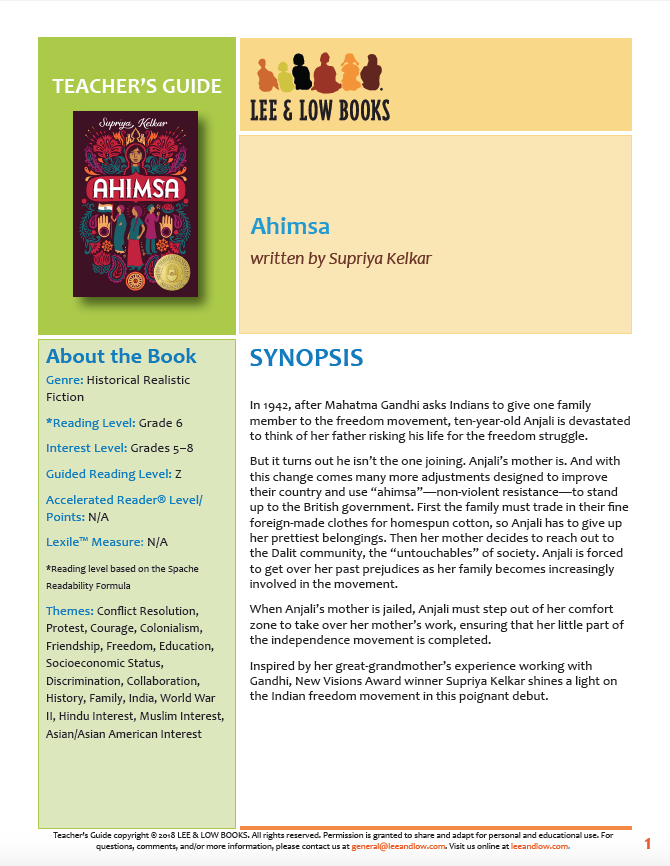 Last October was the release of Ahimsa by New Visions Award winner Supriya Kelkar. Inspired by her great-grandmother’s experience working with Gandhi, Kelkar shines a light on the Indian freedom movement in this poignant middle grade novel.
Last October was the release of Ahimsa by New Visions Award winner Supriya Kelkar. Inspired by her great-grandmother’s experience working with Gandhi, Kelkar shines a light on the Indian freedom movement in this poignant middle grade novel.
In 1942, after Mahatma Gandhi asks Indians to give one family member to the freedom movement, ten-year-old Anjali is devastated to think of her father risking his life for the freedom struggle. But it turns out he isn’t the one joining. Anjali’s mother is. And with this change comes many more adjustments designed to improve their country and use “ahimsa”—non-violent resistance—to stand up to the British government.
Accompanying this title is the Ahimsa Teacher’s Guide, which offers resources and tips on how to guide discussions on the Indian freedom movement, colonialism, civil disobedience, and the connection to the civil rights movement in the United States. Our teacher’s guide also features summary and background information, prereading and discussion questions, ideas for reader’s response and writing activities, strategies for ESL/ELL, and interdisciplinary activities and connections. Below we’ve shared a few prereading questions, discussion questions, and resources from the Ahimsa teacher’s guide.
Prereading Focus Questions:
Before introducing this book to students, you may wish to develop background knowledge and promote anticipation by posing questions such as the following:
- Ask students what they know about India being colonized by Britain. Consider reminding students about the independence of the United States from Britain to familiarize students with colonization prior to engaging with Ahimsa.
- What have you learned about India’s quest for independence from Britain? In what time period did it happen? What have you learned about it from school or from home?
- What do you know about Mohandas Gandhi? What have you learned about him in school or at home?
 Have students read to find out:
Have students read to find out:
- what “ahimsa” means to Anjali, her family, and Indian citizens
- how Anjali’s mother inspires her to join the fight for freedom in India
- how Gandhi’s perception differs among people in India, especially during the freedom movement
- how groups of people, especially in the Indian caste system, are treated and discriminated against
Discussion Questions:
After students have read the book, use these or similar questions to generate discussion, enhance comprehension, and develop appreciation for the content. Encourage students to refer to passages and/or illustrations in the book to support their responses.
- What plea does Anjali hear on the radio? What does the radio announcer ask the people to do?
- What is the ‘Quit India’ movement?
- What does the word ‘ahimsa’ mean? What do Anjali’s mother and father say to her about ahimsa?
- What does Diwali mean to Anjali?
- What does Keshavji say Gandhi fasted for? What does he say about the Dalit people?
Activities:
Use some of the following activities to help students integrate their reading experiences with other curriculum areas. These can also be used for extension activities, for advanced readers, and for building a home-school connection.
- Have students compare and contrast Ma’s and Anjali’s development over the course of Ahimsa. Students should create a Venn diagram that has Ma on one side, Anjali on the other side, and the comparisons in the middle. How are their quests for freedom similar? How are they different? How are their personality traits similar? How are they different? Why is it important to analyze both Ma and Anjali? Based on this exercise, students should answer the following question in an essay: Do Ma and Anjali have similar character growth? Why or why not?
- Have students generate a list of Anjali’s mistakes and how she learned from them. Anjali and her mother both make mistakes throughout the book on their journey of learning about how to be Indian freedom fighters. Have students track Anjali’s mistakes throughout the book and how she learns from them in a T-chart. At the completion of the chart, have students reflect on what Anjali’s mistakes say about her as a person. Is it okay to make mistakes and learn from them? Why?
- Have students create a timeline of the British rule in India until independence. Have students conduct research online about important events in India’s history that led up to independence. Who were important figures in India, besides Gandhi, that helped lead India to eventual freedom? What were important events that happened before the year of 1942? What about after?
We want to hear how you’ve been using Ahimsa in your classroom! Comment below or email our literacy specialist Katie Potter at kpotter@leeandlow.com to share any lessons or activities that you’ve done with your students!
Find the complete teacher’s guide for Ahimsa here.
Purchase a copy of Ahimsa here.








